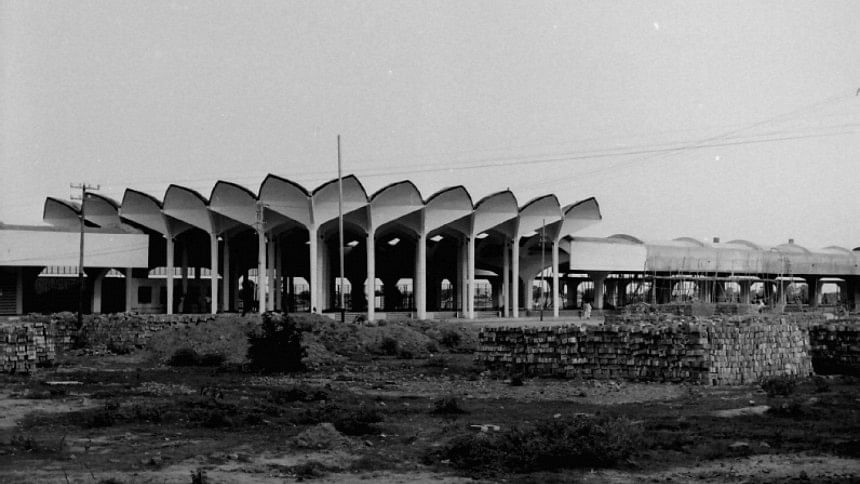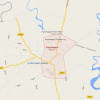A quiet masterpiece that serves as Dhaka's gateway

I didn't have a clue that Bob Boughey was alive and still working in Thailand. Every time I visit the Kamalapur Railway Station, I think of what he described to me a few years ago about the Dhaka of the 1960s. He was a gentleman, courteous, cautious, and sounded a tad melancholic about his memories of Dhaka.
Boughey was one of the two designers of the Kamalapur Railway Station (the other was Daniel Dunham). If you catch a train ride from this station or pass by it, you would notice that it is not one of those familiar colonial-era red-brick buildings that typically served as railway stations across South Asia. The station's parabolic umbrella roof over the terminal was unusual for its time. Along with Louis Kahn's Parliament building, Constantino Doxiadis' TSC, and Richard Vrooman's Architecture Building at BUET, among others, the pioneering structure of the railway station symbolised a "golden age" of architecture in Bangladesh during the 1960s.
These buildings also had a political history. They were the products of what the military regime of Muhammad Ayub Khan called the "Decade of Development" (1958-68), intertwined with West Pakistan's shrewd political strategy of placating East Pakistan's agitating Bengalis through architectural and infrastructure development.
"The inauguration of the new railway station at Kamalapur on April 27, 1968, introduced a new chapter in the history of railway transportation in East Pakistan, now Bangladesh. Not only was it the largest modern railway station in the country, but it also embodied the modernist spirit in architecture that defined the decade of the 1960s.
To understand the significance of Kamalapur, one needs to understand the history of railway in this country. The first railway line in East Bengal—connecting Kolkata with the western Bangladeshi town of Kushtia—was introduced in 1862. Called the Eastern Bengal Railway, this expansion of train service to East Bengal signalled a new phase in the growth of the region's colonial economy. However, the province east of the Padma River, including such urban centres as Dhaka, Chittagong, and Sylhet, long remained deprived of the benefits of railway because the extensive river system of the deltaic country created geographic logistical issues.
Even by 1885, the only railway line on the eastern side of the Padma was the one connecting Dhaka and the northern town of Mymensingh. Still considered a provincial town at that time, Dhaka's railway infrastructure was nominal. The railway station constructed at Phulbaria, demarcating the northern extent of Dhaka, served only the people in and around the urban area. It was a rudimentary facility with one platform, a small yard, and a locomotive shed. The railway line leading to Phulbaria formed a semi-circular northern barrier of the city. However, the train track did not affect the flow of vehicular traffic to and from the area because, the city's total traffic volume was rather small.
During the early 20th century, Dhaka's urban status rose, and its economy grew, even more so after 1947, when it became the provincial capital of East Pakistan. The existing railway line bifurcated the capital into the old city and the new city, expanding northward. The north-south traffic flow was severely hampered because the existing train lines converging at the Phulbaria railway station cut roads at various points.
The most reasonable remedy was to shift the Phulbaria station and divert the railway lines to a less populated and sparsely used area, thus easing the north-south vehicular movement without much hindrance. Furthermore, this move would help unify the old city and the new city. Accordingly, in 1948, experts suggested that the railway station be resituated to its present location at Kamalapur.
However, the proposal came to fruition only a decade later, in 1958, when the provincial government was entrusted with executing the plan. The train line was diverted from Tejgaon to Khilgaon and then to Kamalapur, removing the previous east-west barrier that cut through the middle of the growing city.
The inauguration of the new railway station at Kamalapur on April 27, 1968, introduced a new chapter in the history of railway transportation in East Pakistan, now Bangladesh. Not only was it the largest modern railway station in the country, but it also embodied the modernist spirit in architecture that defined the decade of the 1960s.
At Kamalapur, Dunham and Boughey's design challenge was to create a wide-span structure that would synthesise the language of modern architecture with the requirement of a tropical climate. The result is the unusual concrete roof structure of the train terminal, with a parasol roof that shelters an interconnected series of low-rise structures. The profile of the terminal—a rhythmic pattern of gently-pointed and arched concrete shells—evokes a typical image of tropical conditions, in which an umbrella provides protection from the monsoon rains. The design creates a light-filled and cross-ventilated train terminal, reminiscent of Mughal pavilions, with deeply recessed spatial volumes.
The thin-shelled concrete canopy at Kamalapur reflects the prior experience of both architects. As a student at Harvard, Dunham designed structures with shell concrete. The government agency in charge of the terminal's construction was understandably anxious because of the unusual composition material of the proposed terminal. At Boughey's suggestion, a smaller version of the terminal was constructed to study the structural feasibility of the project. Berger's Stanley Jewkes, an experienced engineer who recently oversaw the construction of large-scale concrete structures in Malaysia, served as the project engineer.
The design of the Kamalapur Railway Station organises various functional spaces, such as ticket booths, administrative offices, passenger lounges, and waiting areas, under one unifying canopy roof.
The concrete roof structure provides a rhythmic visual effect, unifying the spaces below it. The parabolic roofline recalls other contemporary masterpieces, such as Danish architect Jorn Utzon's Sydney Opera House (1957-1973). Just as Utzon's Opera House shaped the skyline of the Sydney harbour, Kamalapur Railway Station's repetitive arches created a new skyline in this low-rise area of the city.
The completion of the Kamalapur Railway Station was hailed as a landmark government accomplishment. Pakistan's President Muhammad Ayub Khan attended the opening ceremony to show that he cared about East Pakistan's development! Commemorative stamps were even issued to celebrate the new terminal.
Today, the parasol roof of the Kamalapur Railway Station continues to provide a unique skyline. It is a gateway that symbolises the architectural energy defining the urban persona of the city. The station also serves as a transition point through which impoverished rural migrants enter the city of "big dreams." As much as it is an icon of the city's modernist architectural heritage, ironically, it transforms into a night time refuge for the city's less-fortunate inhabitants. More than any other building, this architectural masterpiece today presents many social commentaries on the city's grinding life.
This article is excerpted from the author's forthcoming book, DAC/Dhaka in 25 Buildings.
Adnan Morshed is an architect, architectural historian, and urbanist and currently serving as Chairperson of the Department of Architecture at BRAC University. He is the author of Impossible Heights: Skyscrapers, Flight, and the Master Builder (2015) and Oculus: A Decade of Insights in Bangladeshi Affairs (2012).
E-mail: [email protected]










Comments